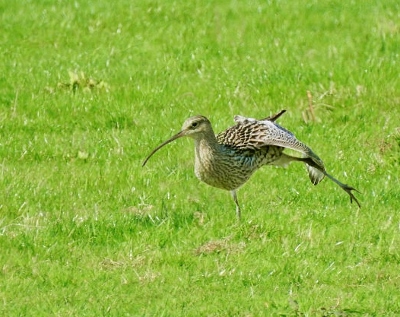Official designation for returning curlews to River Thame
On 23/04/2019 At 11:52 am
Category : Missed a ThameNews story?, More News, Thame news
Responses : No Comments
THE River Thame Conservation Trust (RTCT) has announced that the River Thame flood meadows at Waterstock have received formal designation as a new Local Wildlife Site.

This designation acknowledges Waterstock’s exceptional variety of bird species, including the rare breeding curlew, and its importance as a habitat for otters, other mammals and endangered plants.
Local Wildlife Sites are special places, recognised for having high wildlife value or containing rare or threatened habitats and species of county or national importance. So, it is a serious accolade for the historic, Oxfordshire village of Waterstock’s flood meadows to receive this designation via the Oxfordshire Local Wildlife Sites Project, a partnership between the Thames Valley Environmental Records Centre (TVERC) and Berkshire Buckinghamshire & Oxfordshire Wildlife Trust (BBOWT).
Gaining Local Wildlife Site status after only three years of regular monthly surveys underlines the importance of the Waterstock flood meadows and other habitats as a safe haven for a rich variety of wildlife. For sites where value for birds is a determining factor designation can require five years’ worth of data, but the deciding panel of experts quickly recognised how valuable the flood meadows are, especially for the wide range of bird species that choose to breed, winter or use the flood meadows as a stop off and refueling point when migrating.
Pim Young, Oxfordshire Local Wildlife Sites Project Officer explained: “Across Oxfordshire rough grazing marsh and floodplain habitat is a real rarity. It plays host to some of our most endangered breeding bird species such as curlew – and it also provides crucial wintering habitat for large numbers of birds. We’re delighted that the hard work of volunteer bird surveyors has led to the discovery of such an important new site. This ongoing collection of biological data helps the Oxfordshire Local Wildlife Sites Project build a more detailed picture of the richness of sites, such as this at Waterstock.”
RTCT Surveyor, Nick Marriner commented: “Given this month (April 21) we were celebrating World Curlew Day, it’s very exciting that in recent weeks we have recorded 12 curlews in the Waterstock area. Last year the RSPB estimated there were 10 breeding pairs in the Upper Thames area east of Oxford. To have the majority of them in this area, highlights how important Waterstock and its flood meadows are both locally and regionally and how vital its wild and undisturbed habitat is. The iconic curlew is the UKs largest wading bird species and has one of the most evocative calls of all birds. It adds a real sense of wildness to the area, an ever-rarer feature in the South East of England”
The curlew is one of the UK’s most rapidly declining breeding bird species showing a 46% decline across the UK from 1994-2010. The UK holds 28% of the European breeding population. Curlew has recently been listed by the Joint Nature Conservation Committee as globally near-threatened, one of the few British species on this list. Their decline can be attributed to destruction of habitat and high levels of disturbance.
In over three years of monthly bird surveys* by RTCT volunteer surveyors; 103 bird species were recorded of which 61 are on the protected species list.
Highlights include:
Wading birds – curlew, snipe, lapwing, jack snipe, green sandpiper and oystercatcher;
Wintering Wildfowl – wigeon, teal, shoveler, gadwall, teal and pintail;
Migrating birds – hawfinch, redstart, whinchat, wheatear, sand martin, yellow wagtail
Owls and Raptors – hobby, peregrine falcon, barn owl and tawny owl
Breeding passerines – spotted flycatcher, garden warbler, willow warbler, lesser whitethroat, kestrel, yellow wagtail
“We fairly quickly discovered that Waterstock is a hidden jewel in the crown of the River Thame”, said Sally Rowlands, Chair of the RTCT. “It forms one of the richest areas for wildlife on the river. So, it’s not surprising so many of our endangered wetland birds choose to call it home. It’s brilliant the area is now formally on the birding map of Oxfordshire and the efforts of local landowners recognised for the great work they are doing to provide fantastic habitat.”
And it’s not just birds. Waterstock enjoys regular sighting of otters and cubs using the river. It has 11 species of fish in the river and over 300 species of plants, including bee orchids and the rare great dodder.
Henry Manisty, Waterstock resident said: “I have lived in the village for over 20 years and have always enjoyed seeing kingfishers, grey wagtails and little egrets feeding along the river, and regularly captured otters and polecats on our wildlife cameras. However, it wasn’t until we started working with the RTCT and their volunteer bird surveyors that we were able to monitor professionally the exceptional variety of birdlife. It’s a real honour for my land and our neighbouring flood meadows to become a Local Wildlife Site and a privilege to wake up each morning in the spring hearing the sound of calling curlew.”
The designation and survey process are inspiring significant habitat improvement actions by Waterstock residents and landowners including 12 Owl boxes installed by Bucks Owl and Raptor Group, one barn owl taking up residence within three weeks of installation, plans for a network of ponds to support great crested newts in partnership with the South Midlands Newt Conservation Partnership, plans for a complex of wetland wader scrapes and reed bed habitat and the completion of a fish passage on the main river with RTCT and the Freshwater Habitats Trust.
Local Wildlife Sites are special places and alongside legally protected areas of land, such as Sites of Special Scientific Interest (SSSI), they form vital links across the county and beyond to create a national network of habitats that provide refuges for our country’s diverse flora and fauna.

